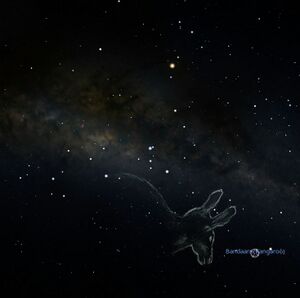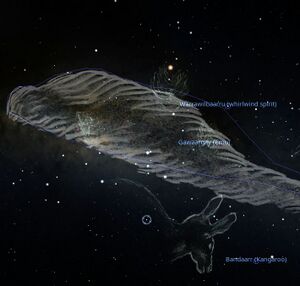Bandaarr: Difference between revisions
No edit summary |
No edit summary |
||
| (3 intermediate revisions by the same user not shown) | |||
| Line 1: | Line 1: | ||
[[File:Bandaarr Stellarium Capture2.JPG|thumb|Bandaarr, the Kangaroo, in Stellarium 2025 for the Kamilaroi Sky Culture. The star marked is zeta Aps, the star in the middle of the body is alf Tel.]] |
|||
Bandaarr, the kangaroo, is an Australian name for an asterism in the area of [[Telescopium]], [[Apus]], and [[Ara]] (the area south of the tail of [[Scorpius]]) from the Kamilaroi/ Euahlayi people. |
Bandaarr, the kangaroo, is an Australian name for an asterism in the area of [[Telescopium]], [[Apus]], and [[Ara]] (the area south of the tail of [[Scorpius]]) from the Kamilaroi/ Euahlayi people. |
||
==Etymology and History== |
==Etymology and History== |
||
[[File:Bandaarr Stellarium Capture.JPG|thumb|Bandaarr as drawn in the Kamilaroi Sky Culture of Stellarium by Robert S. Fuller and Ghillar Michael Anderson ]] |
|||
Variants |
|||
Bandaarr is Kamilaroi/Euahlayi for Kangaroo, and this kangaroo is located under the belly of the Emu in the Milky Way, looking away from the Emu. Bandaarr is either a grey or red kangaroo, depending on the culture, and has significance in ceremony.<ref>Robert S. Fuller and Ghillar Michael Anderson in Stellarium; printed in appendix of Hoffmann and Wolfschmidt (eds.): ''Astronomy in Culture – Cultures of Astronomy.'' Featuring the Proceedings of the Splinter Meeting in the Annual Meeting of the German Astronomical Society, Sept. 14-16, 2021., Reihe: Nuncius Hamburgensis 57, tredition, Hamburg & OpenScienceTechnology Berlin (cBook)</ref> The belly of the Emu is formed by dark clouds in the Milky Way, and "under" it, where the legs of the emu would be, is the area of the constellations mentioned above. |
|||
* |
|||
Fuller (2014)<ref>Fuller, R. (2014) PhD thesis (http://www.aboriginalastronomy.com.au/wp-content/uploads/2018/05/Fuller-Thesis.pdf) </ref> discusses etymology but does not identify any particular stars or groups of stars, and we can find no source online that identifies the stars. |
|||
In Stellarium it appears to be floating in Apus, Telescopium, and Ara, and the star ζ Aps is highlighted, but the reason is unclear. |
|||
==Mythology== |
==Mythology== |
||
==IAU Working Group on Star Names== |
==IAU Working Group on Star Names== |
||
The name was discussed and approved by the IAU WGSN in 2023. We suggest to name the star alf Tel with this name, as it is one of the unnamed main stars of an IAU-constellation, which is an early modern invention without classical background or mythology. Connecting the instrument to an Indigenous constellation would return it to the original significance of constellations (orientation in nature). |
|||
The name was discussed and approved by the IAU WGSN in 2023. |
|||
WGSN chose ... (not to apply/ to apply the name to a neighbouring star/ to ...) in the IAU-CSN. |
WGSN chose ... (not to apply/ to apply the name to a neighbouring star/ to ...) in the IAU-CSN. |
||
Latest revision as of 09:26, 1 October 2025
Bandaarr, the kangaroo, is an Australian name for an asterism in the area of Telescopium, Apus, and Ara (the area south of the tail of Scorpius) from the Kamilaroi/ Euahlayi people.
Etymology and History
Bandaarr is Kamilaroi/Euahlayi for Kangaroo, and this kangaroo is located under the belly of the Emu in the Milky Way, looking away from the Emu. Bandaarr is either a grey or red kangaroo, depending on the culture, and has significance in ceremony.[1] The belly of the Emu is formed by dark clouds in the Milky Way, and "under" it, where the legs of the emu would be, is the area of the constellations mentioned above.
Fuller (2014)[2] discusses etymology but does not identify any particular stars or groups of stars, and we can find no source online that identifies the stars.
In Stellarium it appears to be floating in Apus, Telescopium, and Ara, and the star ζ Aps is highlighted, but the reason is unclear.
Mythology
IAU Working Group on Star Names
The name was discussed and approved by the IAU WGSN in 2023. We suggest to name the star alf Tel with this name, as it is one of the unnamed main stars of an IAU-constellation, which is an early modern invention without classical background or mythology. Connecting the instrument to an Indigenous constellation would return it to the original significance of constellations (orientation in nature).
WGSN chose ... (not to apply/ to apply the name to a neighbouring star/ to ...) in the IAU-CSN.
Weblinks
Reference
- ↑ Robert S. Fuller and Ghillar Michael Anderson in Stellarium; printed in appendix of Hoffmann and Wolfschmidt (eds.): Astronomy in Culture – Cultures of Astronomy. Featuring the Proceedings of the Splinter Meeting in the Annual Meeting of the German Astronomical Society, Sept. 14-16, 2021., Reihe: Nuncius Hamburgensis 57, tredition, Hamburg & OpenScienceTechnology Berlin (cBook)
- ↑ Fuller, R. (2014) PhD thesis (http://www.aboriginalastronomy.com.au/wp-content/uploads/2018/05/Fuller-Thesis.pdf)






